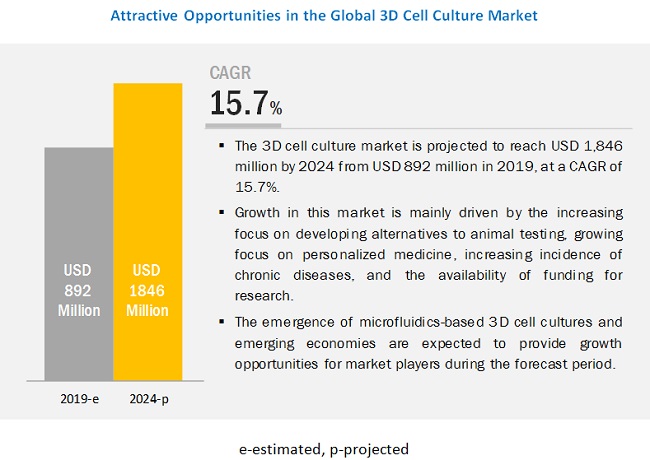
What is the future growth analysis of global 3D
Cell Culture Market?
The 3D
cell culture market is
expected to reach USD 1,846 million in 2024 from USD 892 million in 2019
growing at a CAGR of 15.7%
What are key factors driving growth of
global 3D Cell Culture Market?
The growth of this market is driven mainly by the increasing focus on
developing alternatives to animal testing, growing focus on personalized
medicine, increasing incidence of chronic diseases, and the availability of
funding for research. On the other hand, the lack of infrastructure for 3D
cell-based research and the high cost of cell biology research are expected to
restrain the growth of this market during the forecast period.
What the growth opportunities are in 3D
Cell Culture Market?
1. Untapped Emerging Markets
2. Emergence of Microfluidics-Based 3D Cell Culture
3. Regenerative Medicine, an Alternative to Organ Transplantation
Get More Crucial Insights:
https://www.marketsandmarkets.com/pdfdownloadNew.asp?id=191072847
Global Market Segmentation:
In the current market scenario, there is a
growing demand for 3D cell culture. The market has been categorized based on
the product, end user, application, and region.
Based on application, the 3D cell culture market is segmented into cancer &
stem cell research, drug discovery & toxicology testing, and tissue
engineering & regenerative medicine. The cancer & stem cell research
segment accounted for the largest share of the market in 2018 and is expected
to register the highest CAGR during the forecast period. The increasing
prevalence of cancer and significant funding for cancer research are major
factors driving the growth of this application segment.
Based on product, the market is segmented into scaffold-based 3D cell cultures,
scaffold-free 3D cell cultures, microfluidics-based 3D cell cultures, and
magnetic & bioprinted 3D cell cultures. Scaffold-based 3D cell cultures
accounted for the largest share of the market in 2018. The advantages of
scaffolds in 3D cell culture, such as structural rigidity and the availability
of attachment points, have greatly driven the preference for scaffold-based 3D
cell cultures and ensured the large share of this segment.
Based on end user, the market is segmented into pharmaceutical &
biotechnology companies, research institutes, the cosmetics industry, and other
end users. Pharmaceutical & biotechnology companies accounted for the
largest share of the market in 2018. The presence of a large number of
pharmaceutical & biotechnology companies, an increase in R&D spending
in these companies, and the growing preference for alternative testing models
over animal techniques are the key market drivers in this end-user segment.
Geographic Growth Analysis 3D Cell Culture Market:
North America commanded the largest share of the
market due to the increasing incidence of cancer and the presence of a
well-established pharmaceutical & biotechnology industry. However, the
market in Europe is expected to grow at the highest CAGR during the forecast
period. The growth of the market in Europe is attributed to the growth of its
pharmaceutical and biotechnology industry, recent commercialization of microfluidics-based products, the increasing
presence of major market players, and a large number of research activities
conducted in the region.
Get Expert Analysis and Insights of
Global Market | Download Sample Report:
https://www.marketsandmarkets.com/requestsampleNew.asp?id=191072847
Key Players In Global 3D
Cell Culture Market:
Thermo Fisher Scientific (US), Corning
Incorporated (US), Merck KGaA (Germany), Lonza AG (Switzerland), REPROCELL
Incorporated (Japan), TissUse (Germany), InSphero (Switzerland), Synthecon
(US), 3D Biotek (US), CN Bio (UK), Hamilton Company (US), MIMETAS
(Netherlands), Emulate (US), Hµrel Corporation (US), QGel SA (Switzerland),
SynVivo (US), Advanced BioMatrix (US), Greiner Bio-One International (Austria),
and PromoCell (Germany).

